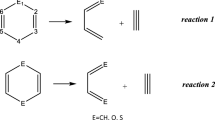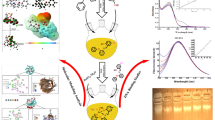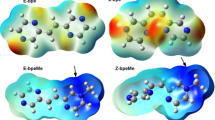Abstract
Trioxatriangulenium (TOTA+, 4,8,12-trioxa-4,8,12,12c-tetrahydro-dibenzo[cd,mn]-pyrenylium) is a closed shell carbenium ion, which is stable in non-nucleophilic polar solvents at ambient temperatures. In alcohols, small quantities of the leuco ether are formed in a reversible reaction. The physical and chemical properties of the excited singlet state of the trioxatriangulenium (TOTA+) carbenium ion are investigated by experimental and computational means. The degeneracy of the lowest excited states is counteracted by Jahn–Teller-type distortion, which leads to vibronic broadening of the long wavelength absorption band. A strong fluorescence is observed at 520 nm (τfl= 14.6 ns, ϕfl= 0.12 in deaerated acetonitrile). The fluorescence is quenched by 10 aromatic electron donors predominantly via a dynamic charge transfer mechanism, but ground state complexation is shown to contribute in varying degrees. Quenching is also observed in the presence of halide ions. Quenching rate constants are derived from lifetime measurements while charge transfer (CT) complex formation constants follow from the steady-state Stern–Volmer plots. CT-complex formation with three discogenic triphenylenes is studied separately. Phosphorescence spectra, triplet lifetimes, and triplet–triplet absorption spectra are provided. In the discussion, TOTA+ is compared to the unsubstituted xanthenium ion and its 9-phenyl derivative with respect to the excited state properties.
Similar content being viewed by others
References and notes
R. A. McClelland, N. Mathivanan and S. Steenken, Laser flash photolysis of 9-fluorenol. Production and reactivities of the 9-fluorenol radical cation and the 9-fluorenyl cation, J. Am. Chem. Soc., 1990, 112, 12, 4857.
D. F. Duxbury, The photochemistry and photophysics of triphenylmethane dyes in solid and liquid media, Chem. Rev., 1993, 93, 1, 381.
L. J. Johnston and D. F. Wong, Electron Transfer Reactions of Triplet 9-Arylxanthenium and 9-Arylthioxanthenium Cations, J. Phys. Chem., 1993, 97, 1589.
A. Samanta, K. R. Gopidas and P. K. Das, Carbocationic fluorescence and its efficient electron-transfer quenching, J. Phys. Chem., 1993, 97, 1583.
A. Azarani, A. B. Berinstain, L. J. Johnston and S. Kazanis, Electron transfer reactions between excited diarylmethyl and triarylmethyl carbocations and aromatic donors, J. Photochem. Photobiol., 1991, 57, 175.
A. Samanta, K. R. Gopidas and P. K. Das, Electron acceptor behavior of 9-phenylxanthenium carbocation singlet, Chem. Phys. Lett., 1990, 167, 165.
Y. Takahashi, S. Sankararaman and J. K. Kochi, Carbocations as electron acceptors. Photoexcitation of the charge-transfer complexes of tropylium salts and aromatic hydrocarbons, J. Am. Chem. Soc., 1989, 111, 8, 2954.
M. K. Boyd, Photochemistry and Photophysics of Carbocations, in Organic Photochemistry, eds. V. Ramamurthy and K. S. Schanze, Marcel Dekker, New York, 1997, p. 147.
F. C. Krebs, B. W. Laursen, I. Johannsen, A. Faldt, K. Bechgaard, C. S. Jacobsen, N. Thorup and K. Boubekeur, The geometry and structural properties of the 4 8,12-trioxa-4,8,12,12c-tetrahydrobenzo[cd,mn]pyrene system in the cationic state. Structures of a planar organic cation with various monovalent and divalent anions, Acts Cryst., 1999, B55, 410.
J. Reynisson, G. Balakrishnan, R. Wilbrandt and N. Harrit, Vibrational spectroscopic and quantum chemical studies of the trioxatriangulenium carbocation, J. Mol. Struct., 2000, 520, 63.
J. C. Martin and R. G. Smith, Factors Influencing the Basicities of Triarylcarbinols. The Synthesis of Sesquixanthydrol, J. Am. Chem. Soc., 1964, 86, 2252.
D. Bethelland and V. Gold, Carbonium Ions, An Introduction, Academic Press, London, 1967, 77.
D. Shukla and P. Wan, Product studies of electron transfer from dimethoxybenzene and trimethoxybenzene to photoexcited xanthenium cations in S1 in aqueous acid solution, J. Photochem. Photobiol. A: Chem, 1993, 76, 47.
I. Nemcová and I. Nemec, The voltammetry of triarylmethane dyes in acetonitrile, J. Electroanal. Chem., 1971, 30, 506.
N. Harrit, J. Reynisson, B. Laursen and R. Wilbrandt, Photophysics of trioxatriangulenes, Book of Abstracts, 216th ACS National Meeting, Boston C.A., 1998: 526577, 1998.
J. Reynisson, Spectroscopic and Photophysical Properties of the Trioxatriangulenium Carbocation and its Interactions with Supramolecular Systems, PhD thesis, 2000, http://www.risoe.dk/rispubl/fys/ris%2Dr%2D1191.htm
S. Dileesh and K. R. Gopidas, Photophysical and electron transfer studies of a stable carbocation, Chem. Phys. Lett, 2000, 330, 3,4, 397.
H. Kessler, A. Moosmayer and A. Rieker, Das ausmass sterischer hinderung in substituirten triarylmethanen und triarylmethyl-radikalen, Tetrahedron, 1969, 25, 287.
N. Isaacs, Physical Organic Chemistry, 2. ed., Longman Scientific & Technical, Essex, 1994, 272.
G. Jones II and K. Goswami, Photoreduction of crystal violet in isopropyl alcohol. Mechanisms involving a leuco ether derivative and dye ion pairs, J. Phys. Chem. A., 1986, 90, 5414.
N. J. Turro, Modern Molecular Photochemistry, Benjamin/Cummings, Menlo Park, 1978, 183.
I. Carmichael and G. L. Hug, Triplet-triplet absorption spectra of organic molecules in condensed phases, J. Phys. Chem. Ref. Data, 1986, 15, 1, 1.
S. L. Murov, I. Carmichael and G. L. Hug, Handbook of Photochemistry, 2. ed., Marcel Dekker, Inc., New York, 1993, p. 264.
J. B. Birks, Photophysics of Aromatic Molecules, Wiley-Interscience, London, 1970, p. 84.
S. J. A. Van Gisbergen, J. G. Snijders and E. J. Baerends, Implementation of time-dependent density functional response equations, Comput. Phys. Commun., 1999, 118, 2–3, 119.
R. E. Stratmann, G. E. Scuseria and M. J. Frisch, An efficient implementation of time-dependent density-functional theory for the calculation of excitation energies of large molecules, J. Chem. Phys., 1998, 109, 19, 8218.
M. Kasha, Phosphorescence and the role of the triplet state in the electronic excitation of complex molecules, Chem. Rev., 1947, 41, 401.
C. Jamorski, J. B. Foresman, C. Thilgen and H. P. Luthi, Assessment of time-dependent density-functional theory for the calculation of critical features in the absorption spectra of a series of aromatic donor-acceptor systems, J. Chem. Phys., 2002, 116, 8761.
J. M. Zwier, J. W. Hoeth, A. M. Brouwer, Computational study of radical cations of saturated compounds with sigma-type and pi-type N-N bonds, J. Org. Chem., 2001, 66, 466.
M. J. Frisch, G. W. Trucks, H. B. Schlegel, G. E. Scuseria, M. A. Robb, J. R. Cheeseman, V. G. Zakrzewski, J. Montgomery, R. E. Stratmann, J. C. Burant, S. Dapprich, A. D. Daniels, K. N. Kudin, M. C. Strain, O. Farkas, J. Tomasi, V. Barone, M. Cossi, R. Cammi, B. Mennucci, C. Pomelli, C. Adamo, S. Clifford, J. Ochterski, G. A. Petersson, P. Y. Ayala, K. Morokuma, D. K. Malick, A. D. Rabuck, K. Raghavachari, J. B. Foresman, J. Cioslowski, J. V. Ortiz, B. B Stefanov, G. Liu, A. Liashenko, P. Piskorz, I. Komaromi, R. Gomperts, R. L. Martin, D. J. Fox, T. Keith, M. A. Al-Laham, C. Y. Peng, A. Nanayakkara, C. Gonzalez, M. Challacombe, P. M. W. Gill, B. Johnson, W. Chen, M. W. Wong, J. L. Andres, C. Gonzalez, M. Head-Gordon, E. S. Replogle and J. A. Pople, Gaussian 98, Revision A.7, Gaussian, Inc., Pittsburgh, 1998.
R. van Leeuwen, E. J. Baerends, Exchange-correlation potential with correct asymptotic behavior, Phys. Rev. A: At., Mot., Opt. Phys., 1994, 49, 4, 2421.
G. Te Velde, F. M. Bickelhaupt, E. J. Baerends, C. Fonseca Guerra, S. J. A. Van Gisbergen, J. G. Snijders and T. Ziegler, Chemistry with ADF, J. Comput. Chem., 2001, 22, 9, 931.
J. B. Foresman, M. Head-Gordon, J. A. Pople and M. J. Frisch, Toward a systematic molecular orbital theory for excited states, J. Phys. Chem., 1992, 96, 1, 135.
H. C. Longuet-Higgins, U. Opik, M. L. Pryce and R. A. Sack, Studies of the Jahn-Teller effect. II. The dynamical problem, Proc. R. Soc. London, Ser. A, 1958, 244, 1.
G. Herzberg, Molecular Spectra and Molecular Structure. III. Electronic Spectra and Electronic Structure of Polyatomic Molecules., D. van Nostrand, Princeton, 1966, 166.
H. P. J. M. Dekkers and E. C. M. Kielman-van Luyt, Magnetic circular dichroism of the triphenyl carbenium ion and some symmetrically para-substituted derivatives, Mol. Phys., 1976, 31, 4, 1001.
A. D. Becke, Density-functional thermochemistry. IV. A new dynamic correlation functional and implications for exact-exchange mixing, J. Chem. Phys., 1996, 104, 3, 1040.
M. S. De Groot, A. M. Hesselmanm and J. H. v. d. Waals, Paramagnetic resonance in phosphorescent aromatic compounds IV. Ions in orbitally degenerate states, Mol. Phys., 1966, 10, 242.
H. Siegerman, Oxidation and Reduction Half-Wave Potentials of Organic Compounds, in Technique of Electroorganic Synthesis, Techniques of Chemistry, ed. N. L. Weinberg, John Wiley & sons, New York, 1975, p. 667.
O. Hammerich, Anodic Oxidation of Hydrocarbons, in Organic Electrochemistry, eds. O. Hammerich and H. Lund, Marcel Dekker, New York, 2001, p. 471.
G. J. Kavarnos, Fundamentals of Photoinduced Electron Transfer, VCH Publishers, Inc., New York, 1993, 35.
W. E. Jones, Jr. and M. A. Fox, Determination of Excited-State Redox Potentials by Phase-Modulated Voltammetry, J. Phys. Chem., 1994, 98, 19, 5095.
D. Rehm and A. Weller, Kinetics of fluorescence quenching by electron and H-atom transfer, Isr. J. Chem., 1970, 8, 259.
M. R. Valentino and M. K. Boyd, Quenching behavior of singlet excited 9-arylxanthylium cations, J. Org. Chem., 1993, 58, 5826.
To calculate ΔG-values, Dileesh and Gopidas apply the irreversible peak potential of 0.106 V versus SCE
J. R. Lakowicz, Principles of Fluorescence Spectroscopy, Plenum Press, New York, 1983, p. 266.
G. Jones II, Photochemistry and Photophysics of Organic Charge Transfer Complexes, in Photoinduced Electron Transfer, part A, eds. M. A. Fox, and M. Chanon, Elsevier, Amsterdam, 1988, p. 245.
D. Baunsgaard, M. Larsen, N. Harrit, J. Frederiksen, R. Wilbrandt and H. Stapelfeldt, Photophysical properties of 2,3,6,7,10,11-hexakis(n-hexylsulfanyl)triphenylene and 2 3,6,7,10,11-hexakis(n-hexylsulfonyl)triphenylene in solution, J. Chem. Soc., Faraday Trans., 1997, 93, 1893.
B. Kohne, W. Poules and K. Praefcke, Erste flüssigkristalline Hexakis(alkylthio)triphenylene, Chem. Zeit., 1984, 108, 113.
C. Destrade, M. C. Mondon and J. Malthête, Hexasubstituted triphenylenes A new mesomorphic order, J. Phys. (Paris), 1979, 40, 17.
D. Markovitsi, H. Bengs and H. Ringsdorf, Charge-transfer absorption in doped columnar liquid crystals, J. Chem. Soc., Faraday Trans., 1992, 88, 1275.
K. Bechgaard, Unpublished work, 2002.
H. A. Benesi and J. H. Hildebrand, A spectrophotometric investigation of the interaction of iodine with aromatic hydrocarbons, J. Am. Chem. Soc., 1949, 71, 2703.
D. Markovitsi, F. Rigaut, M. Mouallem and J. Malthete, One-dimensional energy migration in crystalline and columnar liquid-crystalline phases of 2,3,6,7,10,11-Hexa-n-hexyloxytriphenylene, Chem. Phys. Lett., 1987, 135, 236.
J. Reynisson, G. B. Schuster and N. Harrit, The Interaction between trioxatriangulenium and DNA, to be published
J. Korppi-Tommola and R. W. Yip, Solvent effects on the visible absorption spectrum of crystal violet, Can. J. Chem., 1981, 59, 191.
R. J. Goldacre and J. N. Phillips, The ionization of basic triphenylmethane dyes, J. Chem. Soc., 1949, 1724.
M. K. Boyd, H. L. Lai and K. Yates, Water quenching behavior of excited 9-xanthylium cations in aqueous sulfuric acid solutions, J. Am. Chem. Soc., 1991, 113, 7294.
R. E. Minto and P. K. Das, A laser flash photolysis study of photodehydroxylation phenomena of 9-phenylxanthen-9-ol and photobehavior of related intermediates Enhanced electrophilicity of 9-phenylxanthenium cation singlet, J. Am. Chem. Soc., 1989, 111, 8858.
M. R. Valentino and M. K. Boyd, Ether Quenching of Singlet Excited 9-Arylxanthyl Cations, J. Photochem. Photobiol. A: Chem., 1995, 89, 7.
J. M. Bedleck, M. R. Valentino and M. K. Boyd, Substituent effects on carbocation photophysics 9-arylxanthyl and 9-arylthioxanthyl carbocations, J. Photochem. Photobiol. A: Chem., 1996, 94, 7.
M. K. Boyd, Photochemistry and photophysics of xanthyl and thioxanthyl carboxcations, Spectrum, 1998, 11, 3, 6.
R. A. McClelland, N. Banait and S. Steenken, Electrophilic reactions of xanthylium carbocations produced by flash photolysis of 9-xanthenols, J. Am. Chem. Soc., 1989, 111, 2929.
E. M. Arnett, K. Amarnath, N. G. Harvey and J. Cheng, Determination and interrelation of bond heterolysis and homolysis energies in solution, J. Am. Chem. Soc., 1990, 112, 1, 344.
D. Shukla and P. Wan, Adiabatically photogenerated thioxanthenium cations: Probes of reactivity of nucleophiles toward excited state carbocations in aqueous solution, J. Photochem. Photobrol. A: Chem., 1994, 79, 55.
R. G. Brown and D. Phillips, Quenching of the first excited singlet state of substituted benzenes by molecular oxygen, Trans. Faraday Soc. 2, 1974, 70, 630.
H. J. Dauben and J. D. Wilson, Carbonium ion charge-transfer complexes, J. Chem. Soc., Chem. Commun., 1968, 1629.
M. Feldman and B. G. Graves, Solvent shifts in charge-transfer spectra of tropylium complexes, J. Phys. Chem., 1966, 70, 955.
J. Michl and E. W. Thulstrup, Why is azulene blue and anthracene white? A simple MO picture, Tetrahedron, 1976, 32, 2, 205.
B. W. Laursen, F. C. Krebs, M. F. Nielsen, K. Bechgaard, J. B. Christensen and N. Harrit, 2,6,10-Tris(dialkylamino)-triangulenium ions: Synthesis, structure, and properties of exceptionally stable carbenium ions, J. Am. Chem. Soc., 1998, 120, 12255.
B. W. Laursen and F. C. Krebs, Synthesis of a triazatriangulenium salt, Angew. Chem., Int. Ed., 2000, 39, 19, 3432.
M. Lofthagen, R. VernonClark, K. K. Baldridge and J. S. Siegel, Synthesis of trioxatricornan and derivatives Useful keystones for the construction of rigid molecular cavities, J. Org. Chem., 1992, 57, 61.
Author information
Authors and Affiliations
Additional information
Electronic supplementary information (ESI) available: experimental details and supplementary figures. See: http://www.rsc.org/suppdata/pp/b2/b204954f/
Rights and permissions
About this article
Cite this article
Reynisson, J., Wilbrandt, R., Brinck, V. et al. Photophysics of trioxatriangulenium ion. Electrophilic reactivity in the ground state and excited singlet state. Photochem Photobiol Sci 1, 763–773 (2002). https://doi.org/10.1039/b204954f
Received:
Accepted:
Published:
Issue Date:
DOI: https://doi.org/10.1039/b204954f




